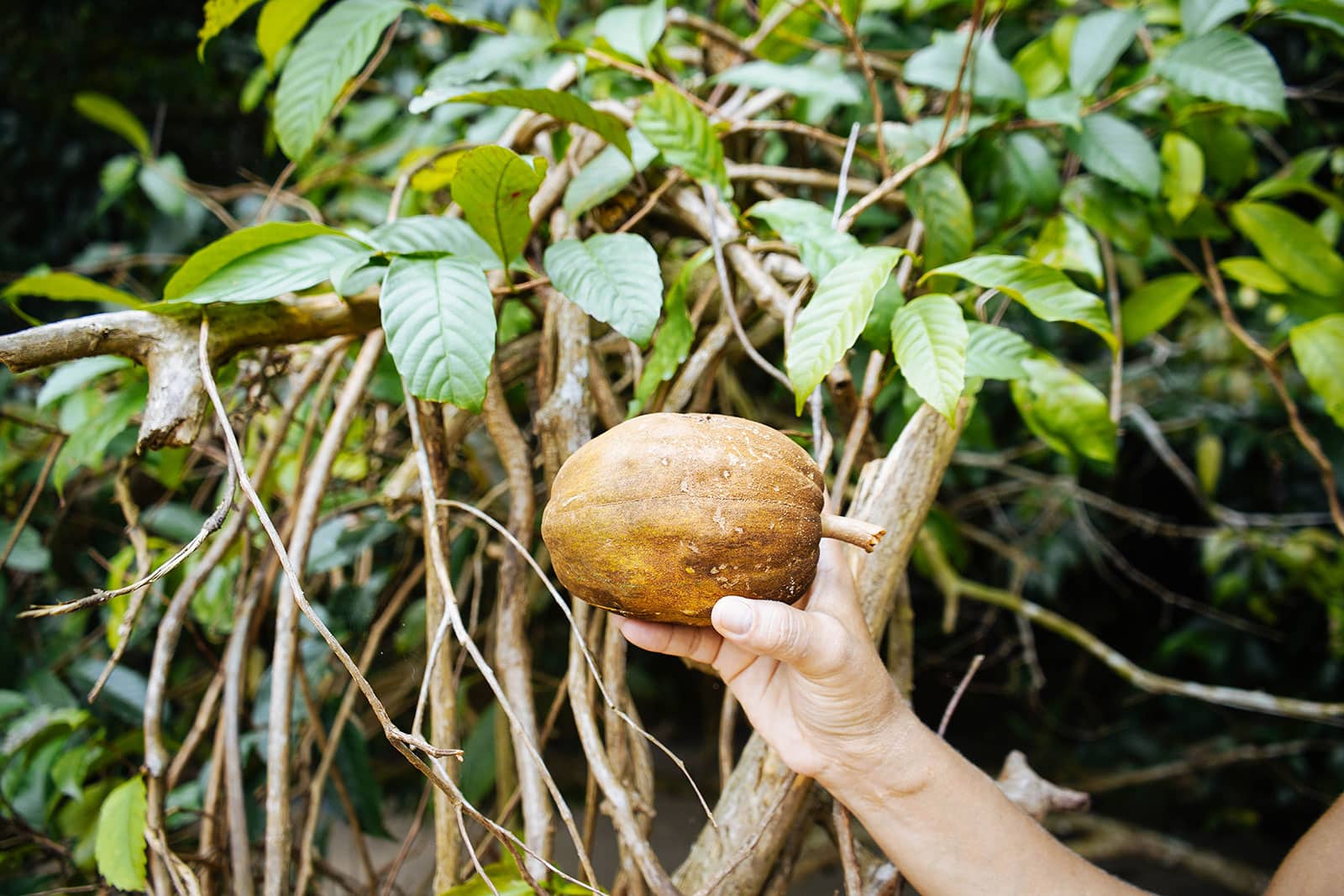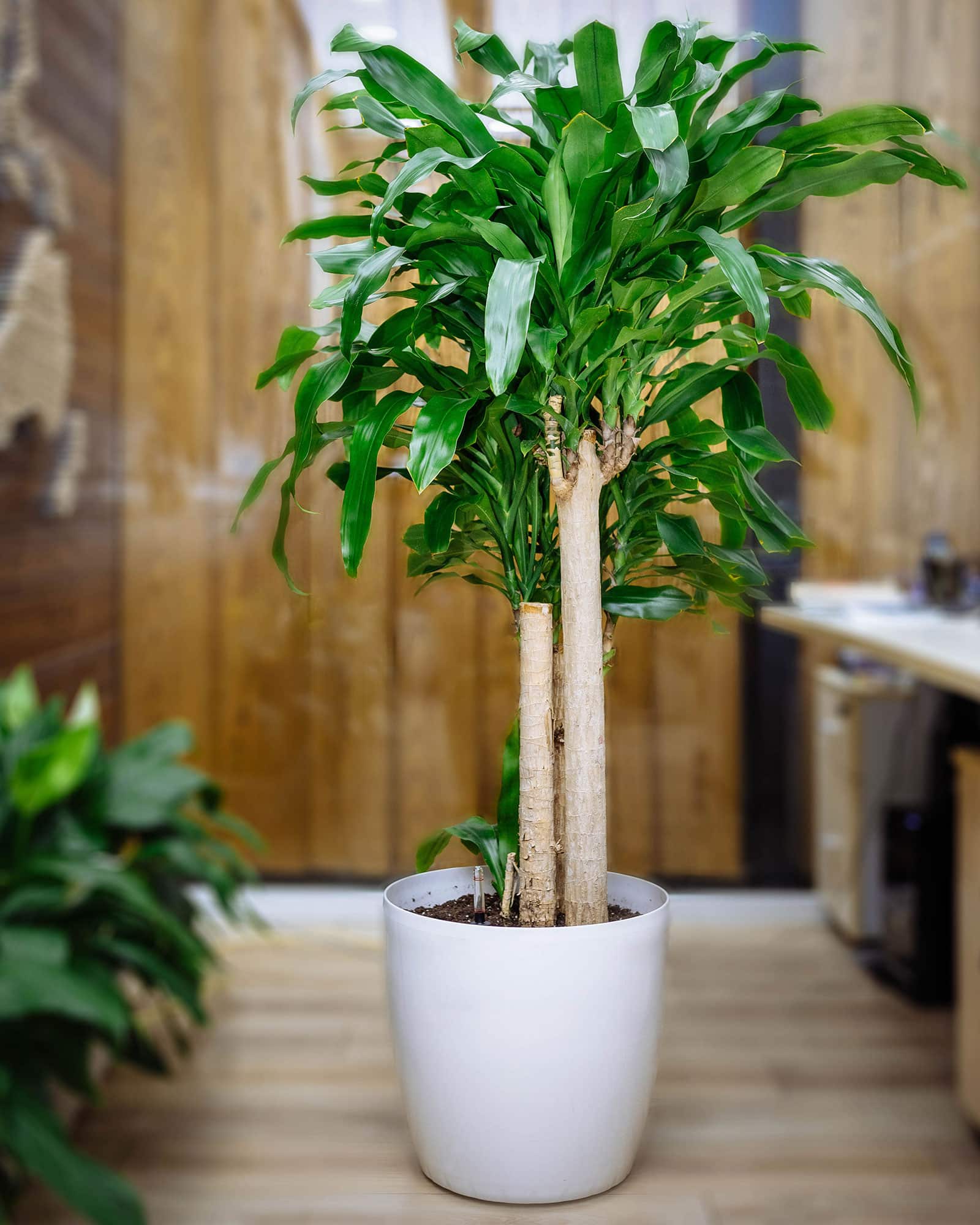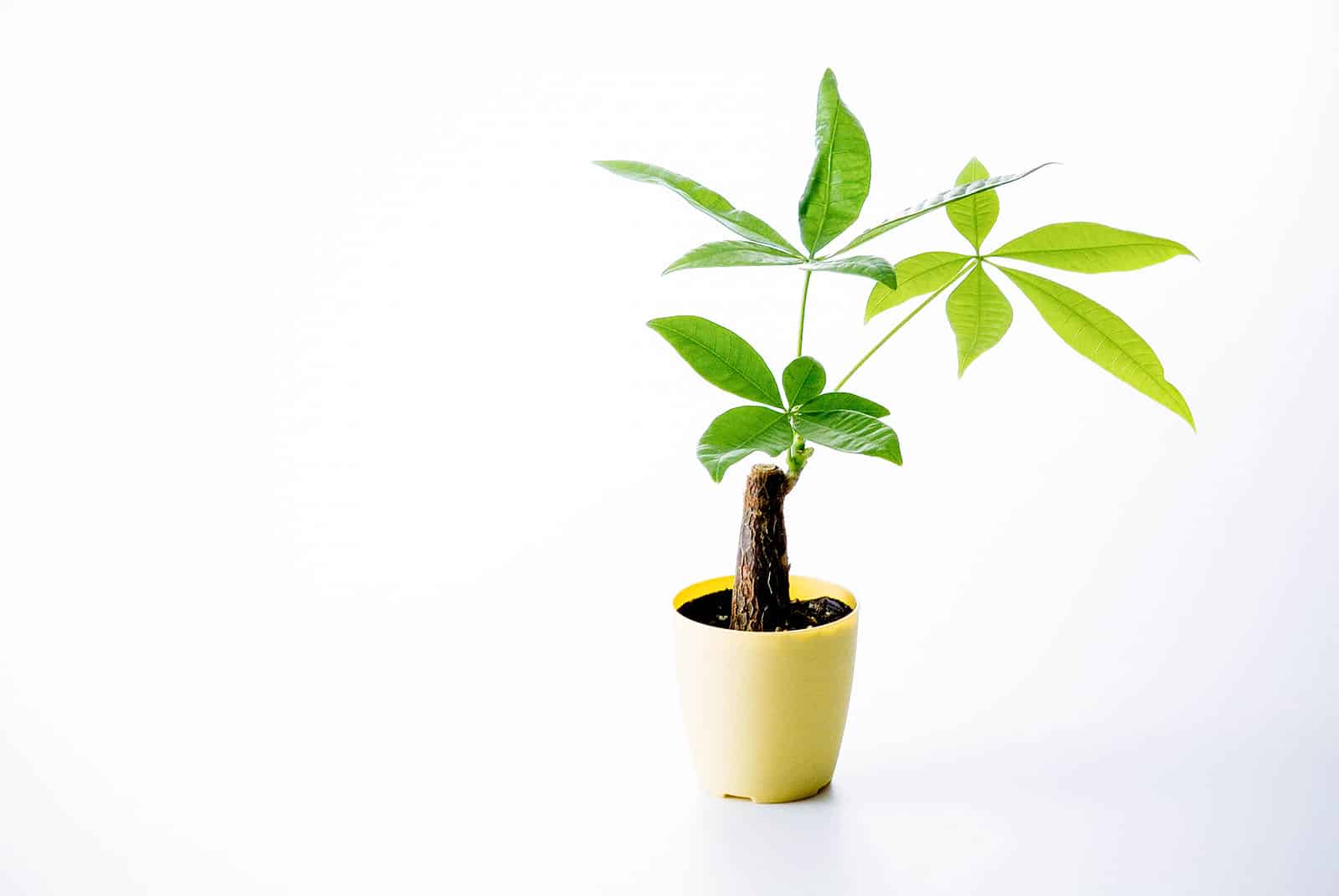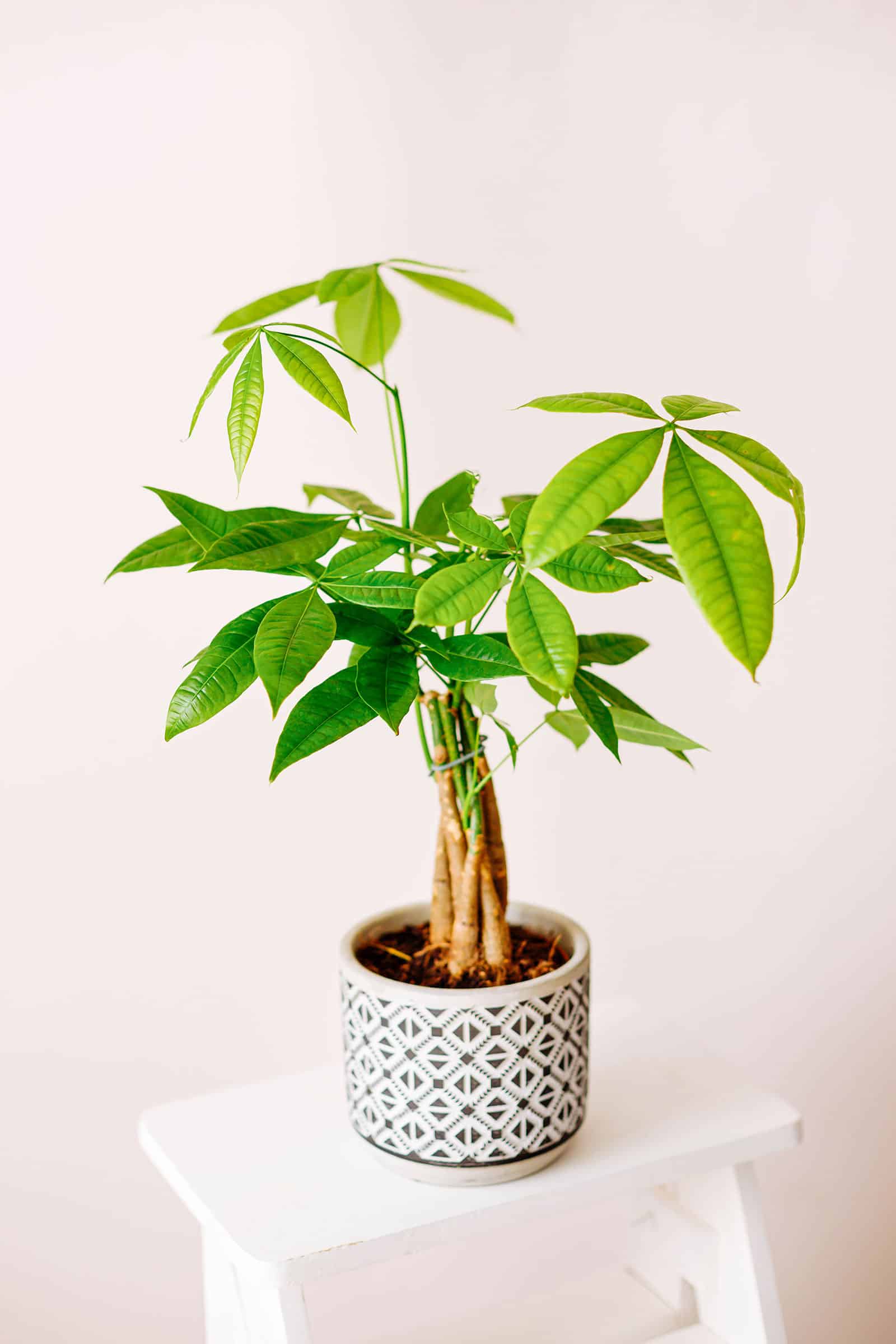Looking for an indoor tree to greenify your home, but worried you won’t be able to keep it alive? I’ve got you covered! Move over cranky fiddle leaf fig and sensitive rubber tree, we’re going back to the classics and opting for the much easier money tree (Pachira aquatica) instead.
Here’s everything you need to know about money tree care and how to grow this tropical tree in your home.
| Common name(s) | Money tree, Guiana chestnut, saba nut, Malabar chestnut |
| Scientific name | Pachira aquatica |
| Family | Malvaceae |
| Height and spread | Up to 10 feet high and 3 feet wide indoors |
| Light | Bright indirect |
| Soil type | Rich, well-draining |
| Water | Keep lightly moist |
Disclosure: If you shop from my article or make a purchase through one of my links, I may receive commissions on some of the products I recommend.

About Pachira aquatica
Description
Also known as the money tree or Guiana chestnut, Pachira aquatica is a tree from the mallow family Malvaceae (the same family as common mallow weed), although it was previously considered a member of Bombacaceae.
In the wild, this species can grow as high as 60 feet and become immensely wide, although luckily it doesn’t tend to surpass 10 feet in our homes!
It’s easy to see why the Guiana chestnut became so popular as an indoor tree as well as for outdoor landscaping. It’s quite nice to look at, with palmate leaves (multiple leaflets sprouting from a central point like a star), smooth stems that are greenish near the crown and very showy flowers (although those are unfortunately not too common on specimens grown indoors).
Because the trunks on these trees are pliable when they’re still small, commercially sold money trees are often braided. If you like this look, you’ll have to continue braiding the stems at home, or they’ll keep growing in their normal form.

In plant stores, you’ll find mini (bonsai) money trees as well as full-sized ones.
Did you know? Some of the plants sold as Pachira aquatica are actually the Brazilian Pachira glabra, which looks very similar but has a thicker base. Luckily, its care is similar as well, so even if you’re unsure which species you’ve got on your hands, you can follow the tips in this care guide just fine.
Natural habitat
As the common name of “Guiana chestnut” suggests, this tree is naturally found in Central and South America, from southern Mexico to northern Brazil and—yep—Guyana.
These regions are tropical to subtropical, and the plant prefers river floodplains with rich soil and good drainage. It’s often found at the edges of mangrove forests, which may flood when the tide is high.
Uses and cultural significance
Although Pachira aquatica originally hails from the Americas, it’s actually more widely commercially used in Asia. There are many different houseplants out there that are referred to as “money plant” or “money tree,” but some sources say that Pachira aquatica is the original or most important one.
(As an aside, Pachira aquatica is not to be confused with another popular houseplant, Pilea peperomioides, that’s commonly called the money plant.)
In some East Asian cultures, Pachira aquatica is considered a bringer of financial prosperity and general good luck.
Various stories float around about how this tree came to be a symbol of good luck, but they all more or less come down to the same thing: A man down on his luck prayed for prosperity, and not long after, came across a small tree he didn’t recognize. He took it home, realized it would do well as a houseplant and ended up growing more from the seeds. People absolutely loved the tree and he ended up making a fortune selling them.
Famously, the concept of the braided money tree was first introduced by a Taiwanese truck driver in the 1980s. It became a roaring success, especially in Japan, and is still an important part of Taiwanese horticultural export.
According to feng shui, money trees are a particularly good choice for businesses, although they can also be grown in the home. The five leaflets that make up a single leaf are considered representative of the five elements of balance (wood, metal, fire, water, earth).
You should preferably place the plant in the southeast corner of your home. The number of braided trunks determines the effects, with eight being referred to as the “golden cage design” and considered the luckiest.
Did you know? Money trees aren’t the only houseplants with a reputation for prosperity. Lucky bamboo is considered a Chinese symbol of good fortune and health as well.
Aside from its status as a bringer of good luck, in its natural range, the bark from this tree is used to make rope and to produce a red dye. It’s also sometimes employed as a natural medicine (for headaches).
Edible or not?!
This tree didn’t get the nickname of Guiana chestnut for nothing. It does actually produce a nut-like fruit whose seeds taste like chestnuts. In the Amazon region especially, the seeds are eaten raw, boiled, fried, or roasted. They can also be ground to make a drink that’s described in The Encyclopedia of Fruit and Nuts to be “similar to hot chocolate.”
Related: Homemade Hot Chocolate Mix from The New Camp Cookbook (+ 3 Hot Chocolate Variations!)
The only problem? Some studies say it’s safe and healthy, others indicate the seeds are toxic or even carcinogenic, especially when raw! I think I’ll pass on them until this matter is resolved.

Pachira aquatica varieties
The money tree is a single species, and unlike some other houseplants, there aren’t many different varieties out there. The differences are mostly in the way trees are braided and presented: three stems, five stems, or even eight stems. Some sources mention a cultivar called ‘Lemon Blush’, but I can’t find any photos or patents for that.
What I have seen are various different variegated money trees, though I’m not sure if these are natural or the result of variegation achieved through chemical manipulation. (This is sometimes done by treating plants with certain chemicals or viruses that cause DNA mutations. While it can produce variegated foliage, the result isn’t permanent and the practice is widely frowned upon.)
They’re very pretty, but if you want one, I hope your wallet is ready. Even small ones tend to go for $500 or more.
Where to buy money trees:

Caring for Pachira aquatica
Light and temperature
In this care guide, I’ll explain why a money tree may be a better choice for your home than something like a fiddle leaf fig, which is more popular but also considered significantly more difficult to care for.
It starts with lighting: whereas fiddles need a lot of sun and tend to languish in our relatively darker homes, Pachira aquatica has no problem with the light levels indoors. It likes bright light, but it’s fine with indirect rather than full sun. You can put yours next to a window, or use some artificial lighting if you don’t have window space available.
The species is quite forgiving when it comes to temperature. Though room temp or above is definitely ideal, it will survive all the way down to around 40°F without suffering too much. Just make sure to water less when it’s cold, as your money tree won’t be growing and doesn’t need as much moisture.
Water and humidity
As mentioned in the above section on habitat, Pachira aquatica is naturally found in river floodplains and other swampy areas. However, since a money tree in a pot doesn’t receive quite the same drainage that a wild one growing in full soil does, it’s usually recommended not to water yours too much in order to prevent issues like root rot.
During summer, when your money tree is actively growing, you can keep the soil lightly moist. (Just let the first few inches dry out before watering again.) During the latent winter period, it’s best to let the soil dry out at least halfway.
Humidity-wise, the money tree isn’t too fussy, but it will suffer if the air in your home is really dry. If things regularly drop below 40 percent humidity, it may be a good idea to run a humidifier.
Soil and planting
To imitate the soil that your money tree would grow in if it were a wild tree in its natural floodplain habitat, you’ll want to go for something both rich and well-draining. After all, these habitats naturally receive a lot of nutritious river gunk, so your Pachira aquatica likes a similar soil in the home!
If you don’t mind using peat, here’s a mixture you could consider:
- 2 parts peat moss
- 2 parts perlite
- 1 part compost
For those who prefer not to use peat, you can replace it with a rich regular houseplant potting soil. If you’d like something store-bought, try looking for a peat- or coir-based cactus or succulent soil mix.
When it comes to a planter for your money tree, anything goes. Just make sure it has a drainage hole in the bottom, which greatly lowers the risk of your plant succumbing to root rot!
Recommended products for money tree care:
- Espoma Organic Cactus Potting Soil
- Perfect Plants Organic Succulent Soil
- Harris Premium Succulent and Cactus Potting Mix
- FoxFarm Ocean Forest Potting Soil
- Perfect Plants Organic Perlite
Fertilizing
Unsurprisingly, a Guiana chestnut will appreciate a bit of fertilizer, at least during the growing months of spring, summer, and early fall. If it’s been a few months since you’ve repotted, it has likely depleted the nutrients in its soil, so you can use a regular liquid houseplant fertilizer once or twice a month.
Be sure not to use fertilizer during winter or if your money tree isn’t doing well. It won’t make it grow better, as the plant won’t be able to take up the nutrients. Instead, it can end up harming the roots.
Recommended fertilizers for money trees:
- Maxsea All-Purpose Seaweed Plant Food
- Houseplant Resource Center Liquid Fertilizer for Houseplants
- Instant Biologics Instant Plant Food (Fizzing Nutrient Tablets)
Pruning and braiding
Money trees don’t need a lot of pruning, except to remove dead leaves and any that you don’t like the look of.
If you have a braided specimen and would like to maintain the look, though, you’ll have to do that once in a while as the tree grows. This is important for those who grow the plant for its symbolism, as the braid is supposed to catch and lock good luck in its tresses.
Make sure to continue the braid while the stems are still young and pliable, optionally using a bit of rope to secure it at the top so it won’t come undone.

Dividing or repotting
Since Pachira aquatica generally isn’t really a candidate for division—unless you’d want to unbraid one and pot up the different stems separately, which probably won’t give a very nice-looking result—you’ll have to repot yours once in a while.
Repotting can be done the next spring after a money tree has begun to outgrow its planter, or every two years or so just to refresh the soil. Go for a planter that’s one size bigger than the previous one and remember that it’s normal for a plant to droop a little after repotting. After all, plants don’t like being disturbed and having their roots manhandled! But yours will perk back up in a week or two.

Propagating Pachira aquatica
As you’ll notice when looking at some of the smaller money trees for sale, especially the Pachira glabra type that’s often sold as P. aquatica, you’ll notice they sometimes have a stump-like look that’s cut at the top (see above image). This reveals how this plant is often produced on a large scale for commercial purposes: by means of stem cuttings.
To multiply your money tree, you can behead it and place the stem you removed in some fresh soil after dipping it in rooting hormone. It should soon root and keep growing, while the headless mother plant will re-sprout from a different growth point.
There are some other money tree propagation options as well:
- Air layering: Tricking the plant into growing roots on its stem before taking a stem cutting, so you can obtain a pre-rooted plant.
- Water propagation: Works best with younger shoots, not woody cuttings.
- Growing from seed: It’s easy enough if you have a heated germination mat and can find some Pachira aquatica seed pods.

Is Pachira aquatica toxic to cats and dogs?
I’ve mentioned that the seeds of the Guiana chestnut are edible, but did you know the same goes for its young shoots and flowers?
Knowing this, it’s not surprising that this plant is generally considered safe to grow around pets and children. Its components are not toxic.
Sources:
- Infante-Mata, D., Moreno-Casasola, P., & Madero-Vega, C. (2014). ¿ Pachira aquatica, un indicador del límite del manglar?. Revista mexicana de biodiversidad, 85(1), 143-160.
- Jorge, N., & Luzia, D. M. M. (2012). Caracterização do óleo das sementes de Pachira aquatica Aublet para aproveitamento alimentar. Acta Amazonica, 42, 149-156.
- Oliveira, J. T. A., Vasconcelos, I. M., Bezerra, L. C. N. M., Silveira, S. B., Monteiro, A. C. O., & Moreira, R. A. (2000). Composition and nutritional properties of seeds from Pachira aquatica Aubl, Sterculia striata St Hil et Naud and Terminalia catappa Linn. Food Chemistry, 70(2), 185-191.
- Rodrigues, A. P., & Pastore, G. M. (2021). A review of the nutritional composition and current applications of monguba (Pachira aquatica Aubl.) plant. Journal of Food Composition and Analysis, 99, 103878.
View the Web Story on how to care for Pachira aquatica (money tree).
















Thanks for your comments on your site. I bought a Money Tree Plant and really like the twisted design. I am having a problem lately with – The leaves getting spots ,and then spread out unto the leaf, then dry out the beautiful green color to a brown crispy spot. I want to take the leaf off but bought some Rheem oil to remove bugs I thought that would help it, I live in Nevada where it’s Straight up dry, thinking I should pull out my humidifier and give it a try, I do spray the leaves with water through out the day. Cause I knew it likes humidity. Well let me know what I should do about the darn spots. Appreciate it
I like channel about money trees because I have one
As fall came and not as much sunlight, the leaves started falling off, and the heater was on as well. All I have are the 3 big braided stumps . Will they grow more stems up? How do I help it? It looks to be potted in peat moss right now. I did add some miracle grow potting soil to it before fall time. Please help!!!
My money tree which I’ve had for a long time is loosing most of its leaves. I repotted it 6 months ago no help. What should I do??
Seems like when I added regular potting soil to mine …. It lost all of its leaves also…